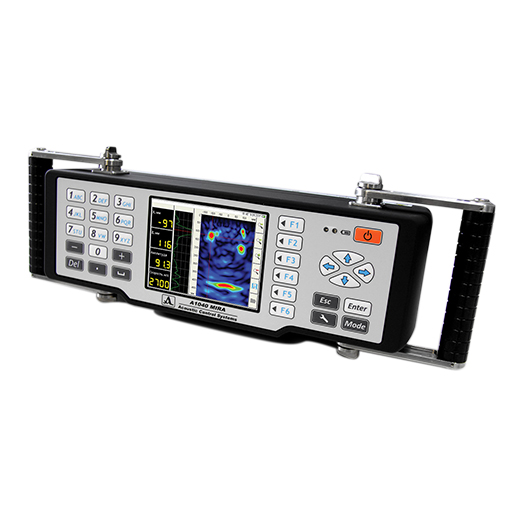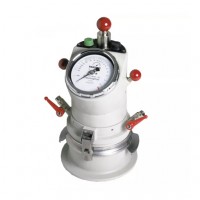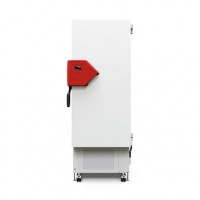A portable handheld ultrasonic tomograph is designed for imaging the internal structure of concrete at one-sided access
The tomograph represents a fully-autonomous measurement unit for the collection and tomographic processing of the data obtained. The measurement unit contains a matrix antenna array from 48 (12 blocks, each containing 4 elements) law-frequency broad banded transducers of shear waves with dry-point contact and ceramic wear-resistant tips. Hence they can work with rough surfaces for a long time. Each transducer is equipped with an independent spring suspension, thus allowing inspection on uneven surfaces. The nominal frequency of the array is 50 kHz.
The instrument’s interface allows working with laser beams that are projected on a surface of the testing object. Hence the operator can correctly maintain a shift step of the antenna array during a complete technical diagnostics of the testing object.
A handheld light-weight body and a repositionable handle provide convenient working with the instrument on the horizontal, vertical, and roof surfaces. A reference scale on the lower part of the instrument’s body is designed for convenient localization of the defects relative to the antenna device.
APPLICATION
- Inspection of concrete constructions up to 2500 mm thickness for the purpose of evaluating of the consistency of the construction.
- Inspection of reinforced concrete constructions up to 800 mm thickness for the purpose of evaluating of consistency of the construction.
- Search for foreign inclusions, cavities, voids, delaminations, leaks of filling and cracks in the concrete objects, reinforced concrete objects, and natural stone.
- Inspection of constructions made of marble and granite up to 2 000 mm thickness.
- Search for plastic and metal pipes of a diameter more than 10 mm in reinforced concrete.
- Inspection of the internal structure of carbon rods of a diameter of more than 900 mm.
- Evaluation of the condition of the channels with stressed reinforcement in reinforced concrete bridges.
- Inspection of understructures, columns, and overhead covers in cast-in-place constructions to detect voids and leaks of filling.
- Search for voids and cavities back of liner plates of underground and railway tunnels.
- Inspection of refractory blocks of the glass blowing furnace.
- Estimation of the thickness of the concrete cover and depth of coverage reinforcement.
- Thickness measurement of the testing object at one-sided access.
- Detailed registration of the results obtained.
| Scanning device | built-in matrix antenna array |
|---|---|
| Operating frequency | 25 – 85 kHz |
| Number of transducers in the antenna array | 48 |
| Type of transducers used in the antenna array | low-frequency broadband |
| Velocity range | from 1 000 to 4 000 m/s |
| Maximum view depth in concrete | 2500 mm |
| Thickness measuring range | 50 – 600 mm |
| Maximum error (X – thickness) | ±(0,05∙Х+10) mm |
| Minimal size of a located reflector | a sphere 20 mm in diameter |
| Display type | 5,7'' TFT, colour |
| Embedded memory | flash 7Gb |
| Power | built-in quick-detachable battery |
| Voltage | 11,2 V |
| Operating time (battery) | 5 h |
| PC connection | USB |
| Operation temperature range | from -10 to +50C |
| Weight | 4,5 kg |
| Size, not more than without handles | 370 х 150 х 145 mm |
| with handles positioned horizontally | 470 х 150 х 170 mm |
| with handles positioned vertically | 370 х 210 х 170 mm |





Do you have a question?
min 10 ch